|
Answers - Two Dimensional Motion
|
|
|
1.
|
You find the resultant
of two vectors graphically by
(a) the parallelogram method or
(b) the polygon method.
In the parallelogram method, complete the parallelogram, as
shown by the dashed lines in Fig. 1a below. The resultant s
is the diagonal.
In the polygon method, move the tail of one of the vectors,
for example s1, to the head of s2.
The resultant s goes from the tail of s2
to the head of s1 as in Fig. 1b below of the
statement of the problem.
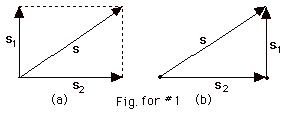
|
|
|
2.
|

- For vectors along a straight line, you can assign a positive
sign for a vector to the right and a negative sign for a
vector to the left. Letting 8 m be to the right and 6 m
to the left, 8 m - 6 m = 2 m. This is also shown in a vector
diagram in Fig. for #2a above. Because the two vectors lie
along the same straight line, I have drawn the vector for
-6 m below the vector for +8 m. Remember two vectors are
equal if they have the same magnitude and direction even
if they do not start at the same point.
- Now let both 8 m and 6 m be to the right: 8 m + 6 m =
14 m. This is also shown in a vector diagram in Fig. for
#2b above.
- Note that (82 + 62)1/2
= 10. If the vectors are at a right angle then the resultant
vector has a magnitude of 10 m, as shown in a vector diagram
in Fig. for #2c above.
|
|
|
3.
|
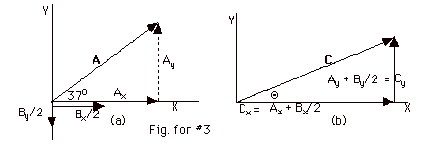
First find the components of A.
Ax = A cos 37o = 10 cm (0.8) = 8 cm
Ay = A sin 37o = 10 cm (0.6) = 6 cm.
We are given that Bx = 8 cm and By =
- 2 cm.
For C = A + 1/2 B, Cx = Ax
+ Bx/2 = (8 + 4) cm = 12 cm
and
Cy = Ay + By/2 = (6
- 1) cm = 5 cm.
C = (122 + 52)1/2 cm = 13
cm. tan Θ = Cy/Cx
= 5/12 = 0.42. Θ=
26o.
Fig. for #3 is shown above.
|
|
|
4.
|

The vector r1 is totally in the +Y-direction.
The component of r1 along the X-axis, r1x
= r2 cos 900 = (7.00 m)0 = 0.
The component of r1 along the Y-axis, r1y
= r1 sin 900 = 7.00 m (1) = 7.00
m. The component of r2 along the X-axis,
r2x = r2 cos 450 = 7.07 m
(0.707)
= 5.00 m.
The component of r2 along the Y-axis, r2y
= r2 sin 450 = 7.07 m (0.707)
= 5.00 m.
The component of r along the X-axis, rx =
r1x + r2x = 0 + 5.00 m = 5.00 m.
The component of r along the Y-axis, ry =
r1y + r2y = 7.00 m + 5.00 m = 12.0 m.
- r = rxi + ryj
= (5.00i + 12.0j) m.
- The magnitude of r = r = (rx2
+ ry2)1/2 = (5.002
+ 12.02)1/2 m = 13.0 m.
tan Θ= 12/5. Θ=
67.40.
|
|
|
5.
|
For motion in the horizontal direction
along the X-axis,
t = x/vx = 60 ft/(132 ft/s) = 0.454 s.
For motion in the vertical direction along the Y-axis,
the vertical drop y = 1/2 at2 = 1/2
(32 ft/s2)(0.454 s)2 = 3.3 ft.
|
|
|
6.
|
- For horizontal motion of the rock,
x = 24 m/s t (Equation
1)
For horizontal motion of the car,
90 m - x = 1/2(4.0 m/s2)t2
(Equation
2)
Substituting Eq. 1 into Eq. 2:
90 m - 24 m/s t = 1/2(4.0 m/s2)t2
or
t2 + 12s t - 45s2 t2
= 0 or
(t - 3s)(t + 15s) = 0 or
t = 3 s.
- Distance fallen by the rock = y = 1/2 at2
= 1/2(10 m/s2)(9s2) = 45 m.
|
|
|
7.
|
For the vertical motion of the ball,
y = 1.0 m = 1/2(10 m/s2)t2 and t = 0.45
s.
For the horizontal motion, x = vxt = (4.0 m/s)(0.45
s) = 1.8 m.
|
|
|
8.
|
The expressions for the quantities t,
ymax, vy(t), and x will all remain the
same. This is exactly what the principle of superposition is
telling you. The object is subjected to two different influences,
an initial velocity and a continuing acceleration due to gravity,
and the object responds to each without altering its response
to the other. The fact that the object has an initial horizontal
velocity does not alter its vertical motion or the time it takes
the object to hit the ground. The fact that the object is subjected
to a vertical acceleration does not change its constant horizontal
velocity motion. As a result you may separate a two-dimensional
problem of a projectile into two one-dimensional problems.
|
|
|
9.
|

- At the initial position i, vix = vo
cos 370 = 25 m/s (0.80) = 20 m/s
and viy = vo sin 370 =
25 m/s (0.60) = 15 m/s.
- At any time, the horizontal component of the velocity
vx = vix + axt
= vix + (0)t = 20 m/s. There is no acceleration
in the x-direction and the object continues to move with
a constant horizontal velocity. At the highest point, the
vertical component of velocity is zero. It does not continue
to move upward. It momentarily stops moving upward and then
moves down. It does continue, however, to have the same
constant horizontal velocity. Notice that this velocity
at h is tangent to the path, as it should be.
- At f, the horizontal velocity still equals 20 m/s. It
takes 3.0 s. to move 60 m (see x position of object just
before it hits the ground in Fig. 3 above) at a constant
horizontal velocity of 20 m/s.
At t = 3.0 s, the vertical velocity v fy(3.0s)
= viy + ayt =
15m/s + (-10 m/s2)(3.0 s) = -15 m/s.
For this symmetrical situation, vfy = -viy.
The final velocity is 25 m/s at an angle of -370.
Notice also for this case where yi = yf
= 0, the time to go half the distance horizontally equals
one-half the total time of flight.
- The velocity at h and f are shown in Fig. 3 above.
- The acceleration is a constant. It is vertically downward
and we took it to be -10 m/s2. The acceleration
vectors are shown at x = 20.0, 30.0, and 40.0 m in Fig.
3 above.
|
|
|
10.
|

Divide this problem into two one-dimensional problems:
| |
X |
Y |
| |
xo
= 0 |
yo
= 20 m |
| |
vox
= 25 m/s (cos 37o) |
voy
= 25 m/s (sin 37o) |
| |
=
25 m/s (0.80) = 20 m/s |
=
25 m/s (0.06) = 15 m/s |
| |
ax
= 0 |
ay
= -10 m/s2 |
| |
vx
= vox + axt = vox = 20
m/s |
vy
= voy + ayt = 15 m/s - 10 m/s2t |
| (c) |
In general, |
vy2(y)
= vo2 + 2ay(y - yo)
|
| |
For this
case, |
= (15 m/s)2
-20 m/s2(y - 20m) |
| |
At highest
point with y = ymax, |
0 = 225
m2/s2 -20 m/s2(ymax
- 20m)
(ymax - 20 m) = 11.25 m
ymax = 31.25 m |
| (d) |
In general, |
y(t) =
yo + voyt + 1/2 ayt2 |
| |
For this
case, |
y(t) =
20 m + 15 m/s t - 5 m/s2t2 |
| |
When the
object returns to earth, |
0 = 20
m + 15 m/s t - 5 m/s2t2 or
t2 - 3 s t - 4 s2 t2
= 0 or
factoring
(t - 4 s)(t + 1 s) = 0 and
t = 4 s |
| (e) |
x(t) =
xo + voxt + 1/2 axt2
x(t) = 0 + 20 m/s t + 0
x(4s) = (20 m/s)(4 s) = 80 m
|
|
| |
vx
= vox |
vy(t)
= voy + ayt |
| (f) |
vx(4s)
= 20 m/s |
vy(4s)
=15 m/s -10 m/s2(4s)
= -25 m/s |
| (g) |
v(4s) =
{(20 m/s)2 + (-25 m/s)2}1/2
= 32.0 m/s.
tan Θ= -25/20
Θ= -51.3o
|
Velocity vectors are drawn on Fig. 4
above.
|
|
|
11.
|
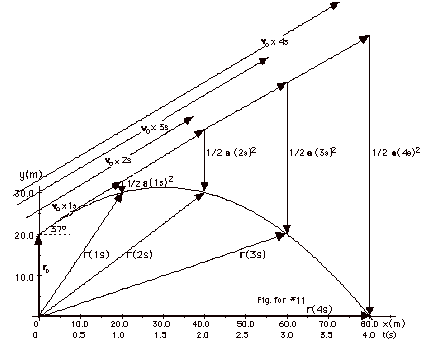
(a) ro = 0i + 20 m j =
20 m j
(b) vo = (20 i + 15 j)
m/s
(c) a = -10 m/s2 j
(d) v(t) = 20 m/s i + (15 m/s - 10 m/s2
t)j
(e) v(t) = (20 m/s i +15 m/s j)
- (10 m/s2 t)j
v(t) = vo
+ at
(f) r(t) = (20 m/s i)t + {20 m
+15 m/s t + 1/2 (-10m/s2)t2}j
(g) = 20 m j + {(20 i + 15 j)
m/s}t + 1/2(-10 m/s2)j t2
=
ro + vo t+ 1/2 at2
The figure above shows how to find r(1s), r(2s),
r(3s) and r(4s) using r(t) = ro
+ vo t + 1/2 at2.
To find r(3s) start out at the origin and go up
20 m, add a vector 37o above the X-axis of vo
x 3s = 25 m/s x 3 s = 75 m. Finally add a vector down
= 1/2 (10 m/s2)(3s)2 = 45 m and you arrive
at the head of r(3s).
|
|
|
12.
|
To catch up to the ball, the horizontal
velocity vb of the boy must equal the initial horizontal
velocity of the ball.
vb = vox = vo cos Θ.
cos Θ= vb/vo
= (20 m/3s)/20 m/s = 1/3.
Θ = 70.5o. voy
= vo sin Θ=
20 m/s sin 70.5o = 18.9 m/s.
For motion in the y-direction, vy(y) = voy2
+ 2 ay(y - yo).
For the highest point, vy = 0 and
0 = (18.9 m/s)2 - 20 m/s2(y - yo).
The ball rises (y - yo) = (18.9)2m/20
= 17.8 m.
|
|
|
13.
|
| X |
Y |
| xo
= 0 |
yo
= 0 |
| vox
= vo cosΘ |
voy
= vo sin Θ |
| ax
= 0 |
ay
= -10 m/s2 |
| xmax
= 180 m for which y = 0 |
|
| x(t) =
voxt |
y(t) =
voyt + 1/2 ayt2 |
| For x =
180 m = (vo cos Θ) t (Equation
1) |
y = 0 =
vo sin Θ
t - 1/2 ayt2
t = 2vo sin Θ/ay
(Equation
2) |
Substituting Eq. 2 into Eq. 1:
180 m = (vo cos Θ)(2vo
sin Θ/ay) = (2vo2
sin Θ cos Θ/ay)
or
vo2 = 90 m ay/sin Θ
cos Θ (Equation
3)
When the ball clears the tree,
x = 30 m = (vo cos Θ)t
and
y = 15 m = vo sin Θ
t - 1/2 ayt2 (Equation
4)
t = 30 m/(vo cos Θ)
(Equation
5)
Substituting Eq. 5 into Eq. (4):
15 m = (vo sin Θ)(30
m/vo cos Θ) -
1/2 ay(30 m/vo cos Θ)2 or
15 m = 30 m tan Θ - 1/2
ay(30 m/vo cos Θ)2
(Equation
6)
Substituting Eq. 3 into Eq. (6):
15 m = 30 m tan Θ - 1/2
ay (30 m/cos Θ)2(sin
Θ cos Θ/90
m ay)
15 m = 30 m tan Θ - 5 m
tan Θ= 25 tan Θ.
tan Θ= 15/25. Θ
= 310
vo2 = 90 m ay/sin Θ
cos Θ . Since
sin 2Θ= 2 sin Θcos
Θ,
vo2 = 180 m ay/sin 2Θ=
180 m(10 m/s2)/0.88.
vo = 45 m/s.
|
|
|
14.
|
When, and only when, a projectile starts
at the ground and ends up at the ground, the time to reach the
highest point equals the time to go from the highest point to
the ground. Since they all go up the same vertical height, the
time involved must be the same. In more detail,
- To go from the highest point take yo = ymax.
At that point, the vertical velocity is zero, so y
= yo + 1/2 at2, where a is the acceleration
of the object. When the object hits the ground, y = 0 =
ymax + 1/2 at2. Since ymax
and a are the same for all objects, the time for the
object to fall or to be in flight is the same.
- At the highest point, the vertical velocity of the object
is zero.
0 = vy = voy+ ayt
and the time is the same for all three projectiles
so voy = vo sin Θ
= ay/t = constant. Thus vo = constant/sin
Θ or vo
is inversely proportional to sin Θ.
The larger the angle, the larger the sine of the angle and
the smaller the initial velocity vo. The initial
velocity is greatest for the smallest angle Θ3.
- The horizontal distance x = (vo cos Θ)t.
As the angle decreases the cosine increases and vo
increases, so the range is the greatest for the smallest
angle Θ3.
|
|
|
15.
|

(a) and (b). The velocity v and the acceleration
a at positions A, B, and C for an object moving with
uniform circular motion are shown in Fig. 6 above. The magnitude
of the velocity is a constant and always tangent to the circle
at the point where you wish to find it. The centripetal acceleration
is constant in magnitude and always in toward the center of
the circle. The centripetal acceleration a = v2/r
= (2.0 m/s)2/0.4 m = 10 m/s2.
(c) While the magnitudes of the velocity and acceleration
are constants, the directions are not. Thus neither v
nor a is constant.
(d) A change in direction of velocity results in an acceleration
just as much as a change in the magnitude of the velocity. You
could use this device to see how many "g's" an object
could withstand.
|
|
|
16.
|
(a) The period = distance moved in one complete rotation/velocity
T = 2 πr/v =
2 π (0.4 m)/2.0 m/s = 0.4 π
s
(b) The frequency = 1/period = 2.5/ π
s-1
(c) From (a), v = 2 πr/T
(d) The centripetal acceleration a = v2/r = (2 πr/T)2/r
= 4 π2r/T2
= 4 π2rf2
= (d)
|
|
|
17.
|
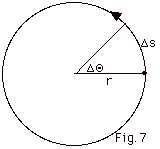
- By definition of an angle in radians,
ΔΘ= Δs/r
(Equation
1)
- Dividing both sides of Eq. 1 by Δt,
ΔΘ/ Δt=
(1/r) Δs/ Δt
limΔt 0
0
ω= dΘ/dt
= (1/r) ds/dt = 1/r (v)
By definition, the velocity v = rate of change of position
= ds/dt.
ω = v/r.
- Curling the fingers of your right hand counterclockwise,
your thumb points out of the page.
- Since the magnitude of the angular velocity = v/r = a
constant and the direction of ω
for counterclockwise motion is out of the page, uniform
circular motion is a case of constant angular acceleration.
Note: use "out of the page" rather than up because
up is in the plane of the page.
|
|
|
18.
|
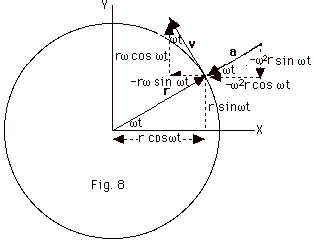
- rx = r cos ωt
ry = r sin ωt
r(t) = r(cos ωt
i + sin ωt j)
- v(t) = dr/dt =
v(t) = ωr(-sin
ωt i + cos ωt
j)
- vx = -ωr
sin ωt
vy = ωr cos
ωt
v = (vx2 + vy2)1/2
= ωr(sin2ωt
+ cos2 ωt)1/2
= ωr
- a(t) = dv/dt
a(t)= -ω2r(cos
ωt i + sin ωt
j) = -ω2r(t)
- ax = -ω2r
cos ωt. ay =
-ω2r sin
ωt
a = (ax2 + ay2)1/2
= ω2r(cos2
ωt + sin2
ωt)1/2 =
ω2r
Since ω = v/r, a = (v/r)2
r = v2/r
|
|
|
|